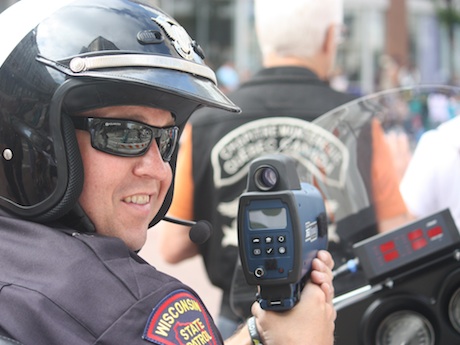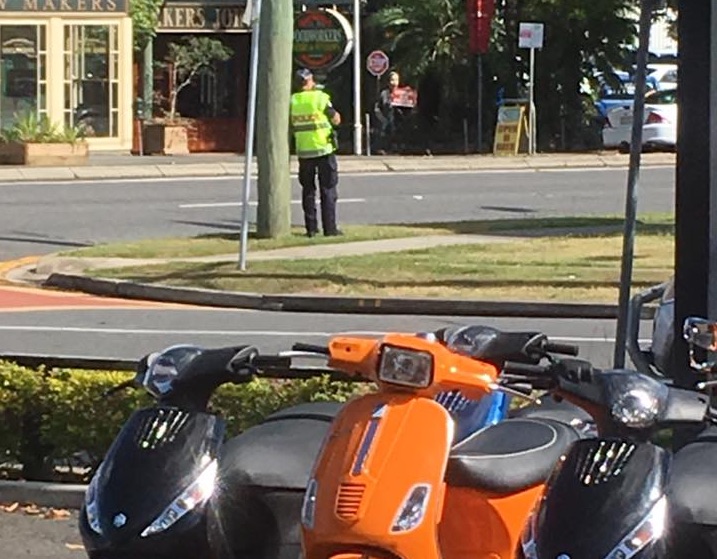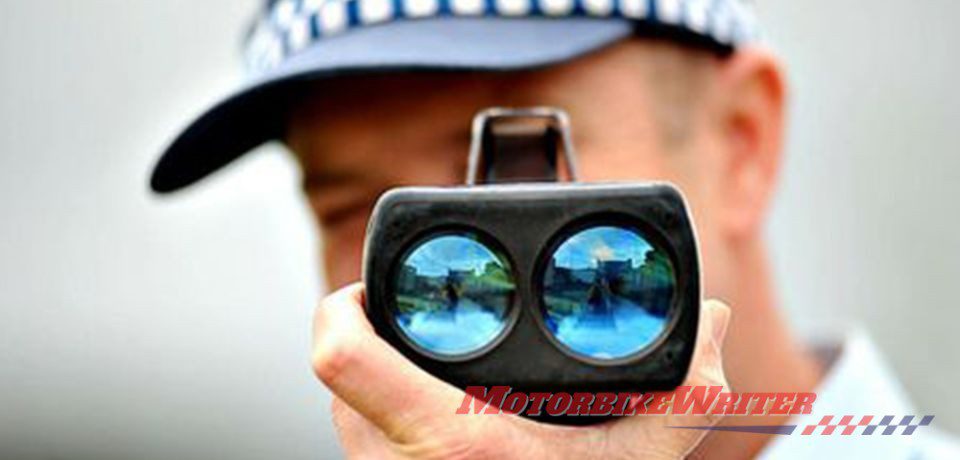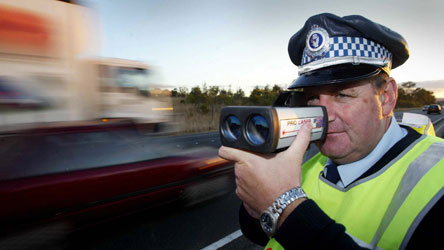South Australia Police is temporarily suspending use of the Lidar speed gun and withdrawing 150 speeding fines after three court decisions found police can misuse the handheld guns.
The three defendants charged with speeding detected by police on Lidar guns had their fines overturned.
Now, SAPOL is temporarily withdrawing Lidar guns until legislation is amended to resolve the legal issues with regard to the evidentiary certificates.
They are also withdrawing 125 speeding fine prosecutions.
South Australian Ride to Review spokesman Tim Kelly says anyone who copped a Lidar speed fine and has not yet paid should apply for a review.
Contact lidarenquiries@police.sa.g
Impact for other states?
While the judgments were delivered in the South Australian Supreme Court, they could have an impact for all states and territories if the calibration of the guns is questioned.
However, there is no movement yet by other states to withdraw Lidar guns.
The three decisions were all based on an argument put forward by lawyer Karen Stanley of Stanley Law. Her full statement on the judgments is included in full at the end of this article.

The judgments are based on a previous case run by Ms Stanley in 2016 case where speeding charges were thrown out because of the police calibration methods for the LIDAR hand-held speed gun. In one of the three recent cases, a motorcyclist was recorded riding 126km/h in a 60 zone in Adelaide.
“My attack was to the certificates that prosecution uses to prove that the guns were accurate,” Karen says.
Lidar gun ‘not at fault’

She points out that the Lidar guns are not necessarily inaccurate or unreliable, but that the police method of calibration, and the way police certify their accuracy, is at fault.
Whether the judgments will apply across all states and territories will depend on the wording of the certificates and what the law says, she says.
“However, I expect that the broad principles His Honour addressed in the substantive case of Police v Hanton, will apply in all states,” she says.
“The Crown may appeal against the judgments so until that time has lapsed, it would not be appropriate to draw conclusions about the future of speeding charges from these judgments” Reviewing methods
Justice David Peek criticised South Australian Police for failing to change their testing system since the 2016 verdict.
He wrote that police appeared willing to “accept the odd setback in terms of a not-guilty trial because the cost of that is less than fixing the system”.
There is no word yet from government on changes to legislation to allow police to start using the guns again.
Meanwhile, SAPOL say they will continue to use other “well-established speed detection options” such as hand-held radar devices and fixed and mobile speed cameras.
Stanley Law statement regarding South Australian Supreme Court Judgments
- POLICE v HANTON [2018] SASC 96
- POLICE v MILLER [2018] SASC 97
- POLICE V HENDERSON [2018] SASC 98
On Thursday 19 July 2018, the South Australian Supreme Court published three significant judgments about the use of hand held LIDAR speed guns to detect vehicle speeds. These cases all relied on the argument successfully raised in Police v Butcher, a 2016 Supreme Court decision that resulted in speeding charges against the defendant being dismissed. While the individual cases are complex, the unifying issue in each was the reliance by prosecution on a certificate to prove the accuracy of the speed guns used to detect the speed of the defendants’ vehicles. Justice Peek found that the certificate relied on by the prosecution was not capable of proving the accuracy of the speed gun to within the margin of error stated in the certificate.
To be clear; the Supreme Court did not say that the speed guns were inaccurate. Rather, the Court found that prosecution could not prove that the devices were accurate by relying on the certificate. Speculation on social media that the judgments have “proved” that speed guns are inaccurate and unreliable, is incorrect.
There is always a presumption of innocence and prosecution must prove, beyond reasonable doubt, that the offence was committed. One of the things that prosecution need to prove for speeding charges is that the device used to detect the vehicle is accurate. It would be cost prohibitive for prosecution to prove the technology behind the speed devices in every case. This would require experts to give evidence at every trial on how the devices work. To simplify this, the law in Australia allows the prosecution to rely on certificates, signed by a senior police officer, that certify the accuracy of the speed gun used. That certificate then becomes proof of the accuracy of the speed gun and the onus then switches to the defendant to provide “proof to the contrary” of what is certified.
While it may appear that this shifting of the evidentiary burden means that in speeding cases the defendant has to prove that they are not guilty, in actual fact, this only occurs once prosecution have proved that the device is accurate. It’s the certificate that prosecution relies on to prove this. The burden of proof only switches to the defendant once there is proof of the accuracy of the device.
The argument in the 2016 case, and in each of the three judgments handed down last week, was that the prosecution could not rely on the certificate because prosecution could not prove that the gun was accurate to the extent certified in the certificate, ie, within a margin of +2/-3kph. Without the certificate, there was no evidence of the accuracy of the device and therefore prosecution could not prove the speed of the vehicle. This is why the alleged speed of the defendant was irrelevant. For these purposes it does not matter whether the alleged speed was 5kph over the speed limit or 100kph over the speed limit.

Speed guns are required to be calibrated every 12 months in accordance with the Australian Standards. This involves an extensive process of testing the gun in a simulator. When a speed gun is calibrated, a report is issued which states that the gun is accurate to within a specific margin of error.
In addition, police are required to perform a number of daily tests, as prescribed by the manufacturer. These tests are recorded as pass/fail. The law requires that these tests are performed on the day that the device is used. The results of these tests are then used when producing the certificate.
In each of judgments published in July 2018 Justice Peek held that prosecution could not rely on the certificate because the daily testing by police doesn’t show that the devices are accurate to within +2/-3kph. The finding in each of these cases is the defendant did not need to prove that the device was inaccurate, but only that the daily testing done by police didn’t prove that the device was accurate to the extent claimed in the certificate. Without the certificate the prosecution was unable to prove the speed of the vehicles.
In addition, Justice Peek made a number of criticisms of the current testing regime of speed detection devices, and the circumstances under which the certificates are issued. Justice Peek further expressed concern that despite warnings in 2016 (Butcher) and 2017 (Henderson), the prosecution of speeding charges has continued without addressing the issues raised in the earlier cases.
SAPOL has issued a statement confirming that they are assessing the judgments “to fully comprehend if changes need to occur”. These judgments make it abundantly clear that changes need to occur. While SAPOL and prosecution continue to prosecute speeding charges in the manner they have to date, defendants will continue to have speeding charges dismissed. The argument first raised in Police v Butcher is clearly not a “one-off” as stated at the time.
The judgments handed down last week are lengthy and complex and will require further analysis in order to determine what ramifications these judgments have beyond the individual cases, although it is already clear that the broader implications are significant.
There is some commentary on social media about what impact these judgments will have on expiation notices issued since SAPOL was first put on notice about problems with relying on the certificates. At this stage it is too early to speculate on this.




